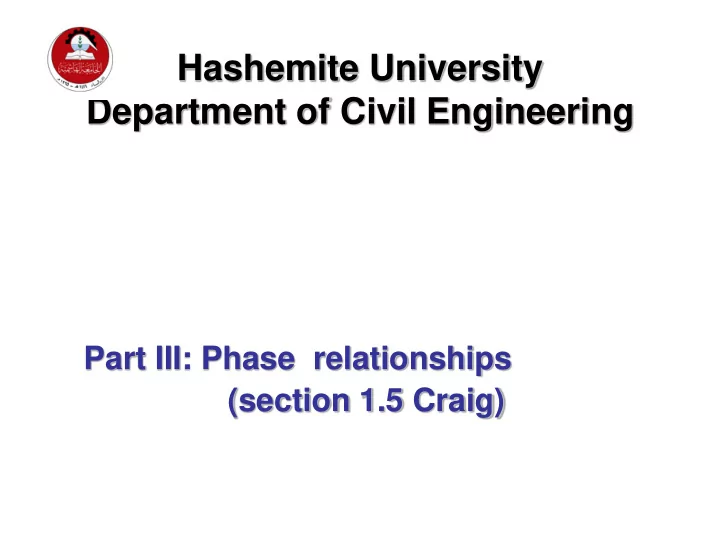

Hashemite University Department of Civil Engineering Part III: Phase relationships (section 1.5 Craig)
Part I: Soil Mechanics Volume-Volume relation Mass-Mass relation Mass-Volume relation Derivative formulas
The nature of Soil Sand Grain Void Space Soil is any uncemented or weakly cemented accumulation of mineral particles formed by the weathering of rocks. The void space between the particles can be filled with Liquid Water and/or Gas (Air)
Volume -Volume Relation Water = Solids Vs = volume of soil solids Vw= volume of water Va=volume of air Vv = volume of voids V = total volume of soil
Volume -Volume Relation • The void ratio (e) is the ratio of the volume of voids to the volume of solid • The porosity (n) is the ratio of the volume of voids to the total volume of the soil, • The degree of saturation (Sr) is the ratio of the volume of water to the total volume of void space The Sr can range between the limits of 0 for a dry soil and 1 (or 100%) for a saturated soil.
Volume -Volume Relation specific volume ( v ) is the total volume of soil which contains unit volume of solids, The air content or air voids (A) is the ratio of the volume of air to the total volume of the soil
Mass-Mass Relation • The water content (w), or moisture content (m), is the ratio of the mass of water to the mass of solids in the soil,
Mass-Mass Relation • The bulk density ( ) of a soil is the ratio of the total mass to the total volume, Convenient units for density are kg/m 3 or Mg/m 3 . The density of water (1000 kg/m 3 or 1.00 Mg/m 3 ) is denoted by w . • The specific gravity of the soil particles (Gs) is given by where s is the particle density.
Derived Relation The degree of saturation can be expressed as In the case of a fully saturated soil, Sr = 1; hence The air content can be expressed as or
Derived Relation The bulk density of a soil can be expressed as or For a fully saturated soil (Sr = 1) For a completely dry soil (Sr = 0)
Unit Weights The unit weight ( ) of a soil is the ratio of the total weight (a force) to the total volume, or
Unit Weights where w is the unit weight of water. Convenient units are kN/m 3 , the unit weight of water being 9.8 kN/m 3 (or 10.0 kN/m 3 in the case of sea water). When a soil in situ is fully saturated the solid soil particles (volume: 1 unit, weight: G s w) are subjected to upthrust ( w ). Hence, the buoyant unit weight ( ) is given by or
Relative density In the case of sands and gravels the density index (I D ) is used to express the relationship between the in-situ void ratio (e), or the void ratio of a sample, and the limiting values e max and emin. The density index (the term ‘relative density’ is also used) is defined as The density index of a soil in its densest possible state (e = e min ) is 1 (or 100%) The density index in its loosest possible state (e = e max ) is 0.
EXAMPLE 1 In its natural condition a soil sample has a mass of 2290 g and a volume of 1.15x10 -3 m 3 . After being completely dried in an oven the mass of the sample is 2035 g. The value of Gs for the soil is 2.68. Determine 1. the bulk density, 2. unit weight 3. water content, 4. void ratio, 5. porosity, 6. degree of saturation and 7. air content.
EXAMPLE 2 Given =1.76Mg/m 3 , s =2.7Mg/m 3 and w=10% • 1. the dry density, 2. void ratio, 3. porosity, 4. degree of saturation and 5. air content 6. and Saturated density Hint Use the total Volume =1m 3
Recommend
More recommend